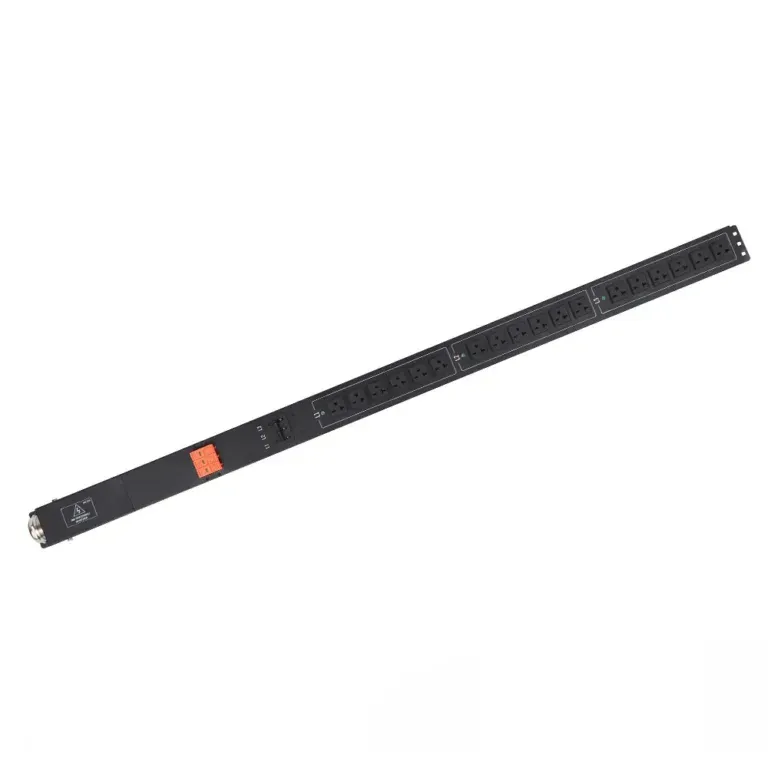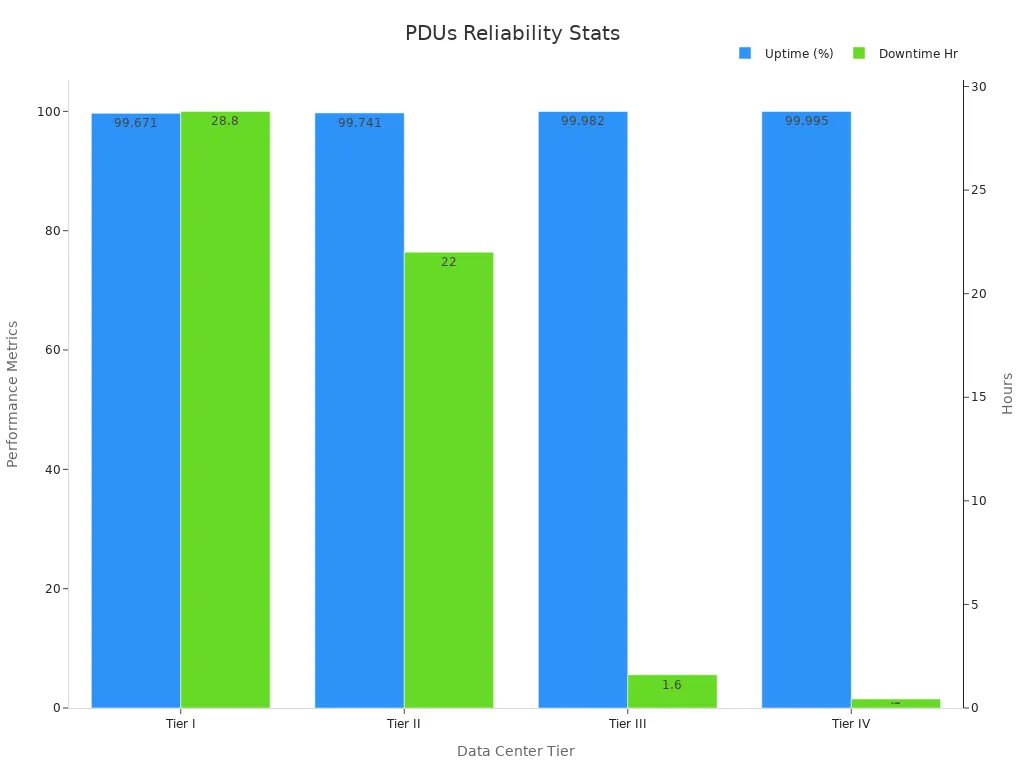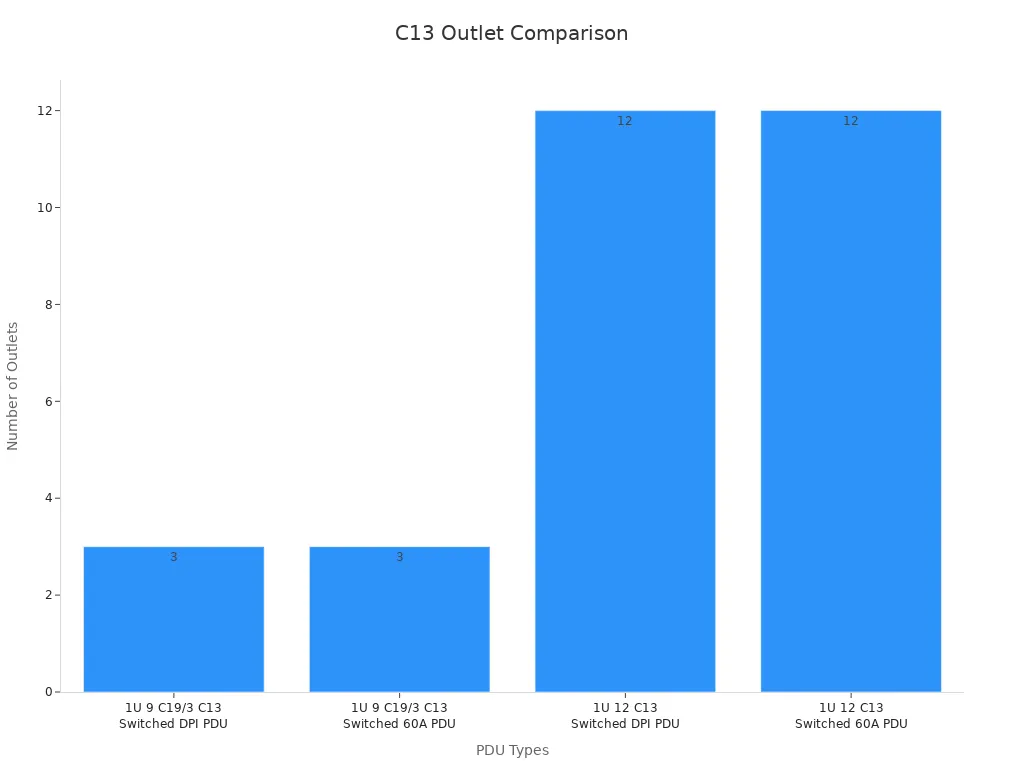© Copyright – 2010-2023 : All Rights Reserved. Sitemap
Power Distribution Unit PDU, rack mount PDU, PDU data center, Smart PDu, intelligent PDU
Power Distribution Unit PDU, rack mount PDU, PDU data center, Smart PDu, intelligent PDU
DTI-CX 2025 Digital Transformation Indonesia Conference, DATE:6-7 AUG.2025, Booth No.: C21

Choosing the right cabinet power distribution unit can make a big difference in how a data center runs. Each PDU type—basic, metered, monitored, and switched—offers unique features for reliability and control. Industry data shows that better power management with the right PDU can prevent up to 80% of outages and improve operational performance by 25%. NBYOSUN provides certified, high-quality power distribution unit solutions that help data centers lower costs and boost safety.
A cabinet power distribution unit is a device that manages and delivers electrical power to multiple pieces of equipment inside a rack or cabinet. It acts as the central hub for power distribution in environments where many devices need reliable electricity. The main components include input breakers, output transformers, subfeed breakers, surge suppression devices, and integrated metering systems. These units often support voltage transformation, such as converting 380-600 Vac input to 208 Vac output. They also feature control panels for configuration and communication modules for remote monitoring. Performance metrics include input and output voltage, current, kVA, kW, frequency, percent loading, and load profiling. Many units offer real-time monitoring of power consumption and outlet-level monitoring to improve uptime. Advanced models include environmental sensors for temperature and humidity, which help protect sensitive equipment.
Note: Cabinet power distribution units ensure efficient power distribution, prevent overloads, and allow upgrades or servicing without downtime. This reliability is essential for critical operations.
Cabinet power distribution units play a vital role in data centers and IT environments. They help manage power distribution to servers, storage devices, and networking equipment. These units support high-density setups by providing multiple outlets and advanced safety features. In data centers, PDUs often use 400V three-phase power distribution to reduce energy loss and copper usage. Intelligent units provide real-time monitoring of current, voltage, kW, and kWh with high accuracy. Environmental sensors track temperature and humidity, sending alerts if conditions move outside safe ranges. Power management software collects data from multiple units, allowing detailed reporting and configuration management. This approach improves operational efficiency and uptime.
NBYOSUN stands out as a trusted provider of cabinet power distribution units. The company holds certifications such as ISO9001, CE, UL, and RoHS, which show a strong commitment to quality and safety. NBYOSUN’s products meet international standards and serve clients in telecom, data centers, and other industries. Their expertise ensures that each power distribution cabinet delivers reliable performance and supports the needs of modern IT operations.
Cabinet power distribution units come in several types, each designed for different needs and environments. Understanding these types helps organizations choose the right solution for their data centers, server rooms, or industrial setups. The main types include basic, metered, monitored, and switched PDUs. Each type offers unique features and benefits for power distribution and management.
A basic PDU provides a simple way to distribute electricity to multiple devices inside a cabinet or rack. It works much like a power strip, offering several outlets for equipment. Basic PDUs do not include advanced features such as monitoring or remote control. Their design focuses on reliability and ease of use.
Market research shows that while intelligent PDUs are gaining popularity, many organizations still prefer basic PDUs for cost-conscious and small-scale environments. These units remain a top choice for users who need reliable power distribution without extra features.
NBYOSUN offers Basic PDU Solutions that meet international standards. These units provide multiple outlets, surge protection, and robust construction. They are ideal for data centers, telecom rooms, and industrial applications where simplicity and reliability matter most.
A metered PDU adds a digital display or meter to show real-time power usage. This feature helps users monitor the total load on the unit and avoid overloading circuits. Metered PDUs do not provide remote access or outlet-level monitoring, but they offer valuable data for managing power consumption.
Studies highlight the importance of metering accuracy. Problems like mis-programmed meters or false readings can affect data reliability. Utilities and IT managers use checks and algorithms to ensure accurate readings. Accurate meter data supports load balancing, outage management, and energy efficiency improvements.
NBYOSUN’s product range includes metered PDUs that deliver precise power usage data. These units help organizations manage energy use and maintain safe operations in data centers and server rooms.
A monitored PDU takes power management a step further by enabling remote monitoring of power usage. These units connect to a network, allowing users to track power consumption from anywhere. Monitored PDUs provide detailed data at both the unit and outlet levels.
In real-world applications, monitored PDUs help data centers find idle servers and optimize energy use. They also aid in balancing loads, reducing waste heat, and improving cooling efficiency. Features like environmental sensors for temperature and humidity add another layer of protection.
NBYOSUN supplies monitored PDUs that integrate with IT infrastructure. These units provide accurate power data, support remote management, and help maintain uptime in critical environments.
A switched PDU combines remote monitoring with the ability to control power to individual outlets. Users can turn outlets on or off remotely, which helps manage equipment and respond to emergencies. Switched PDUs are essential for high-demand environments where uptime and flexibility are critical.
Operational data shows that switched PDUs deliver high reliability in demanding settings. Brands like NBYOSUN, Eaton, and Vertiv design switched PDUs with robust construction, high-speed switching, and advanced safety features. For example, the NBYOSUN 3 Phase 32A IEC C13 C19 0U pdu distribution unit offers 24 locking outlets, overload protection, and a durable aluminum shell. This model suits data centers, mining farms, and other high-demand environments, ensuring consistent power flow and safety.
| Brand | Key Features | Reliability Context |
|---|---|---|
| NBYOSUN | 3 Phase 32A IEC C13 C19 0U, 24 locking outlets, overload protection, durable aluminum shell | High-demand environments, data centers, mining farms |
| Eaton | Industrial-grade, high-speed switching, software integration | Manufacturing, healthcare, data centers |
| Vertiv | Overload protection, fault detection, fast transfer | Hospitals, telecom hubs, critical infrastructure |
| Tripp Lite | User-friendly, clear labeling, reliable distribution | Small businesses, home offices |
Switched PDUs often use hydraulic-magnetic breakers and built-in surge suppression for extra protection. These features help maintain uptime and protect valuable equipment.
Note: The global market for power distribution units is growing rapidly. In 2024, the market reached about 6.95 billion USD and is expected to grow to 12.89 billion USD by 2034. The demand for high-density and intelligent PDUs continues to rise as more organizations adopt advanced computing and IoT devices.
NBYOSUN’s product range covers all major PDU types, including basic, metered, monitored, and switched models. The company’s solutions, such as the 3 Phase 32A IEC C13 C19 0U pdu distribution unit and Basic PDU Solutions, meet international standards and serve clients in data centers, telecom, and industrial sectors. These products ensure safe, reliable, and efficient power distribution for every application, from simple offices to complex, high-density environments.
Reliability and safety stand at the core of every quality pdu. Modern units include features such as overload protection, locking outlets, and built-in surge suppression. These features help prevent equipment damage and reduce downtime. For example, the NBYOSUN 3 Phase 32A IEC C13 C19 0U pdu distribution unit uses a heavy-duty aluminum shell and locking outlets to ensure a secure connection. Overload protection automatically trips the circuit if the current exceeds safe limits, protecting valuable devices.
Certifications play a key role in reliability. Many pdus meet standards like FCC Part 15 Class A, TUVus, IEC 62368, and NEMA. These certifications confirm that the pdu operates safely and reliably in demanding environments. The table below shows how these certifications benefit users:
| Certification/Standard | Benefit |
|---|---|
| FCC Part 15 Class A | Confirms electromagnetic interference compliance |
| TUVus | Certifies electrical safety and performance |
| IEC 62368 | Ensures safety and reliability for IT equipment |
| NEMA | Establishes safety standards for electrical products |
Surge protection devices in pdus help reduce costly downtime. Power surges cause billions in damages each year, but built-in protection keeps operations stable.

Advanced monitoring and control features make pdus smarter and more efficient. Metered pdus display real-time power usage, helping users track trends and plan capacity. Monitored pdus allow remote tracking of voltage, current, and energy use. Switched pdus add the ability to control outlets remotely, making it easy to reboot or shut down equipment.
| PDU Subtype | Monitoring Accuracy and Control Features |
|---|---|
| Metered PDUs | Measure total power consumption; data displayed locally or remotely |
| Switched PDUs | Remote switching of outlets; power cycling and rebooting |
| Metered-by-outlet PDUs | Measure power per outlet; detailed device-level usage data |
| Switched-metered-by-outlet PDUs | Combine metering and switching per outlet; highest granularity and flexibility in control |
Monitored pdus track key metrics like current, wattage, voltage, and frequency. Real-time monitoring helps detect problems quickly and reduces the need for on-site checks. Integration with management software allows for centralized control, improving efficiency and reliability.
Customization and compliance ensure that pdus meet the needs of different industries and regions. NBYOSUN offers pdus with flexible voltage options, supporting 208V, 400V, 415V, and even 480V. This flexibility allows deployment in many countries. Custom features like K-factor harmonic filtering and configurable breakers help meet strict power quality standards.
NBYOSUN’s pdus undergo rigorous testing to meet international standards. These units comply with global safety codes and adapt to the fast growth of AI and HPC workloads. Customization ensures that every power distribution solution fits the client’s exact requirements, supporting both reliability and compliance.
Data centers rely on cabinet PDUs to keep servers and network equipment running smoothly. Basic PDUs work well for simple racks that need steady power distribution. Metered PDUs help staff monitor energy use and prevent overloads. Monitored and switched PDUs allow remote management and control, which is important for large facilities. NBYOSUN provides solutions like the 3 Phase 32A IEC C13 C19 0U PDU distribution unit, which supports high-density racks and offers overload protection. These features help data centers avoid downtime and improve efficiency. Real-time monitoring and environmental sensors also protect equipment from heat and humidity.
Note: Intelligent PDUs in data centers can reduce downtime by up to 30% and save 20-25% on energy costs through better load balancing and proactive management.
Server rooms and telecom sites need reliable power distribution to support critical communication systems. Metered and monitored PDUs give operators real-time data on power use. This helps them spot problems early and balance loads across circuits. Studies show that 80% of outages in these environments could be prevented with better monitoring and load balancing. NBYOSUN’s PDUs, trusted by major telecom companies, offer surge protection and modular designs. These features make maintenance easier and keep operations running without interruption. Remote management lets staff reboot devices quickly, even if they are not on site.
Industrial sites and specialized environments, such as mining farms or research labs, require PDUs that can handle high loads and harsh conditions. Intelligent PDUs offer advanced features like remote monitoring, load balancing, and locking outlets for safety. Market analysis shows that the global market for cabinet PDUs will grow by 11% from 2024 to 2025, driven by demand in these sectors. NBYOSUN’s heavy-duty PDUs, with robust aluminum shells and overload protection, help prevent outages caused by equipment failure. Integration with modern infrastructure, such as overhead busway systems, improves energy efficiency and scalability.
Selecting the right PDU for a cabinet or rack depends on several important factors. Each type offers different features, such as the number of outlets, circuit breakers, and management options. The table below compares key design parameters and performance metrics for several common cabinet PDU models. This quick reference helps users see the differences at a glance.
| Parameter / Metric | 1U 9 C19/3 C13 Switched & Monitored DPI PDU | 1U 9 C19/3 C13 Switched & Monitored 60A 3 Phase PDU | 1U 12 C13 Switched & Monitored DPI PDU | 1U 12 C13 Switched & Monitored 60A 3 Phase PDU |
|---|---|---|---|---|
| Part Number | 46M4002 | 46M4003 | 46M4004 | 46M4005 |
| Line Cord | Detachable (varies) | Permanently attached (IEC 309 3P+Gnd) | Detachable (varies) | Permanently attached (IEC 309 3P+Gnd) |
| Rated Voltage & Current | 200-250 V, 24-63 A | 200-208 V, 48 A (60 A derated), 3-phase Delta | 200-250 V, 24-63 A | 200-208 V, 48 A (60 A derated), 3-phase Delta |
| Max Power Rating (VA) | Up to ~23040 VA | 17292 VA | Up to ~23040 VA | 17292 VA |
| Number of Phases | Single or 3-phase wye | 3-phase power delta | Single or 3-phase wye | 3-phase power delta |
| Number of C13 Outlets | 3 | 3 | 12 | 12 |
| Number of C19 Outlets | 9 | 9 | 0 | 0 |
| Circuit Breakers | 9 double-pole, 20 A each | 9 double-pole, 20 A each | 6 double-pole, 20 A each | 6 double-pole, 20 A each |
| Physical Dimensions (HxWxD) | 43.9 mm x 447 mm x 350 mm | Same as left | Same as left | Same as left |
| Operating Environment | 10 to 60 °C, 8% to 80% RH (non-condensing) | Same as left | Same as left | Same as left |
| Management Methods | Web browser, Telnet, SNMP, Serial | Same as left | Same as left | Same as left |
| Environmental Monitoring Probe | Included (temperature & humidity sensors) | Included | Included | Included |
Tip: The number of C13 and C19 outlets can affect how many devices a user can connect. More outlets provide greater flexibility for power distribution in high-density racks.

The chart above shows the difference in the number of C13 outlets among these PDU types. Some models offer more C13 outlets, which can support more standard IT equipment. Others focus on C19 outlets for higher-power devices. Users should match the PDU type to their equipment needs and management preferences.
A quick reference table like this helps data center managers and IT staff make informed decisions. They can compare features, such as circuit breaker count, management methods, and environmental monitoring, to choose the best fit for their power distribution needs.
Selecting the best cabinet power distribution unit starts with a careful review of technical requirements and future plans. Data center managers often look at several key factors:
Tracking real-time power readings and peak loads helps identify unused capacity and supports better planning. Monitoring power and data port availability also guides equipment placement, making operations more efficient.
Tip: Local metered units display real-time power use, helping staff avoid overloads and manage energy better than basic models.
NBYOSUN stands out with a strong record of reliability, safety, and customer satisfaction. The company’s products deliver measurable benefits:
| Feature Category | Details and Metrics |
|---|---|
| Energy Savings | Up to 20% reduction in energy use reported by data centers |
| Equipment Uptime | 15% improvement in uptime due to intelligent monitoring and smart features |
| Downtime Reduction | 30% decrease in downtime after switching to NBYOSUN units |
| Certifications | ISO9001, CE, UL, VDE, RoHS for global safety and quality |
| Build Quality | Heavy-duty aluminum alloy housing, anodized frame, antiflaming PC modules |
| Safety Features | Overload protection, 16-amp circuit breaker, resettable protector |
| Customization | Options for cable length, shell color, plug types (Schuko, Italian, EU) |
| Customer Support | Fast response, technical assistance, tailored solutions for high-density environments |
| Real-World Client Use | Trusted by China Mobile, China Telecom, Lenovo |
| Cost Effectiveness | Competitive pricing, long-term savings through efficiency and reduced downtime |
NBYOSUN’s smart units offer real-time monitoring, remote management, and environmental sensors. These features help data centers and telecom companies reduce manual checks, prevent downtime, and save on energy costs. The company’s flexible customization options and strong support make it a top choice for organizations with unique needs. Positive feedback highlights reliability, easy installation, and advanced safety features.
Selecting the right cabinet power distribution unit depends on power needs, monitoring, and control. The table below highlights the main differences:
| Feature | Basic PDUs | Smart PDUs |
|---|---|---|
| Power Capacity | Simple power sharing | Advanced control with live monitoring |
| Monitoring | None | Real-time tracking |
| Control | Manual only | Remote and automated |
| Extra Features | None | Environmental sensing and alerts |
NBYOSUN offers certified, customizable solutions for every environment. Users should review their equipment needs and plan for future growth before choosing a PDU.
A basic PDU distributes power without monitoring or control features. A smart PDU offers real-time monitoring, remote management, and advanced safety. Data centers often choose smart PDUs to reduce downtime and improve energy efficiency by up to 25%.
NBYOSUN PDUs use built-in circuit breakers. When the current exceeds safe limits, the breaker trips and cuts power. This feature protects connected devices from damage caused by electrical surges or faults.
Yes. Intelligent PDUs with monitoring features help staff track energy use and balance loads. Studies show that using monitored or switched PDUs can lower energy costs by 20% through better management and early detection of waste.
NBYOSUN PDUs hold certifications like ISO9001, CE, UL, and RoHS. These certifications ensure the products meet global safety and quality standards. Clients in over 30 countries trust NBYOSUN for reliable and compliant power solutions.
A Professional And Leading Manufacturer
For OEM
& ODM Power Distribution Unit (PDU)
You Can Trust
CONTACT
Ningbo YOSUN Electric Technology Co., LTD
Leading Professional Manufacturer in PDU Power Solutions
Contact Info.